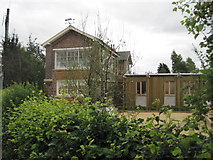I live by the former Highland Railway branch which went between Alves Junction and Hopeman. There is very little left in terms of buildings; the station building at Hopeman still exists, as does the one at Alves Junction (both are private residences). The Burghead station building was still there when I was younger, but unfortunately it succumbed to fire a few years ago and was destroyed. The Burghead site has since been cleared, the road overbridge demolished and the sidings which served the maltings have been lifted; all the grain traffic now goes by road.
Hopeman still has its platforms, one of which I assume was for goods, and the site is now the West Beach Caravan Park. Had it not been for the caravans, I suspect the land would have been developed for housing a long time ago.
As far as I'm aware, apart from the road bridge in Burghead, all the original bridges are still intact. The alignment between Burghead and Hopeman is now part of the Moray Coastal Trail and is tarmacked between Burghead and Cummingston. There are a couple of rusty remnants of gates that were probably foot crossings along the way. In one spot, part of the embankment has been eroded away, but the path has been diverted around this.
The connection to the Aberdeen - Inverness line was severed when they did the A2I improvements a few years ago, but the track still exists between Alves and Burghead; it was very overgrown the last time I looked. I'm fairly certain the sidings at Roseisle Maltings are still there, and there used to be a halt at Coltfield where there's both an overbridge and a level crossing.

 It's hugely comprehensive and gets regular updates. Many of the photos on the site were shot by Nick Catford, who is hugely knowledgeable on abandoned places in the UK - he's a big authority on Cold War bunkers as well.
It's hugely comprehensive and gets regular updates. Many of the photos on the site were shot by Nick Catford, who is hugely knowledgeable on abandoned places in the UK - he's a big authority on Cold War bunkers as well.

